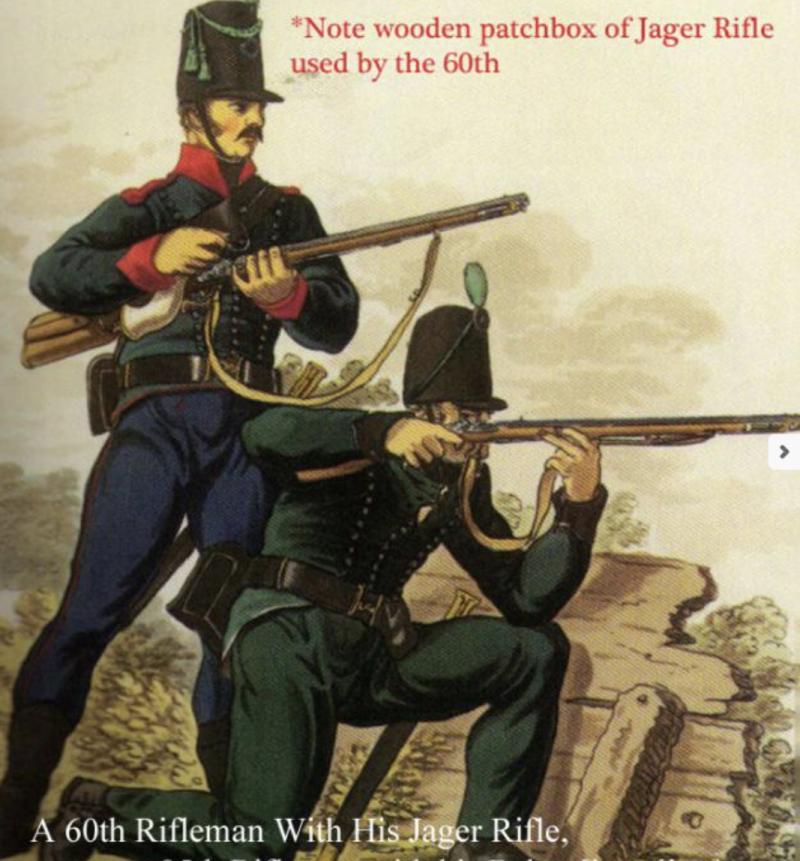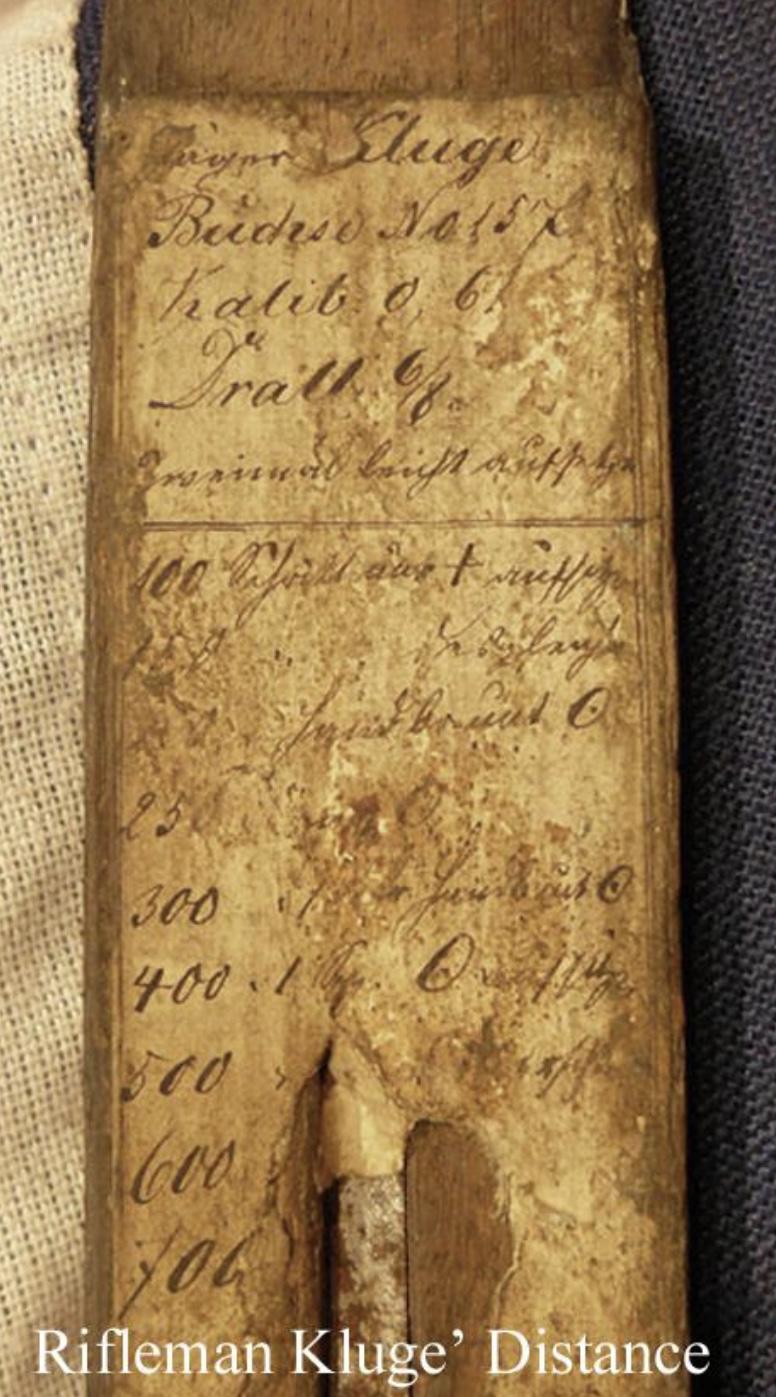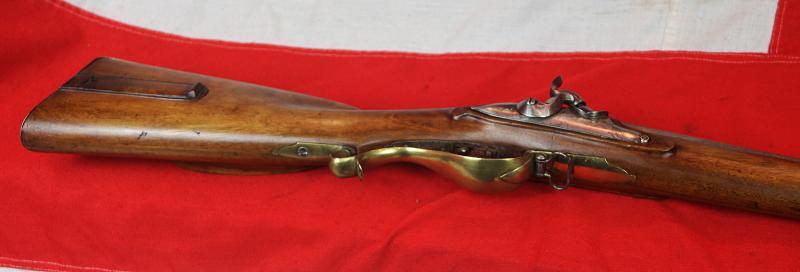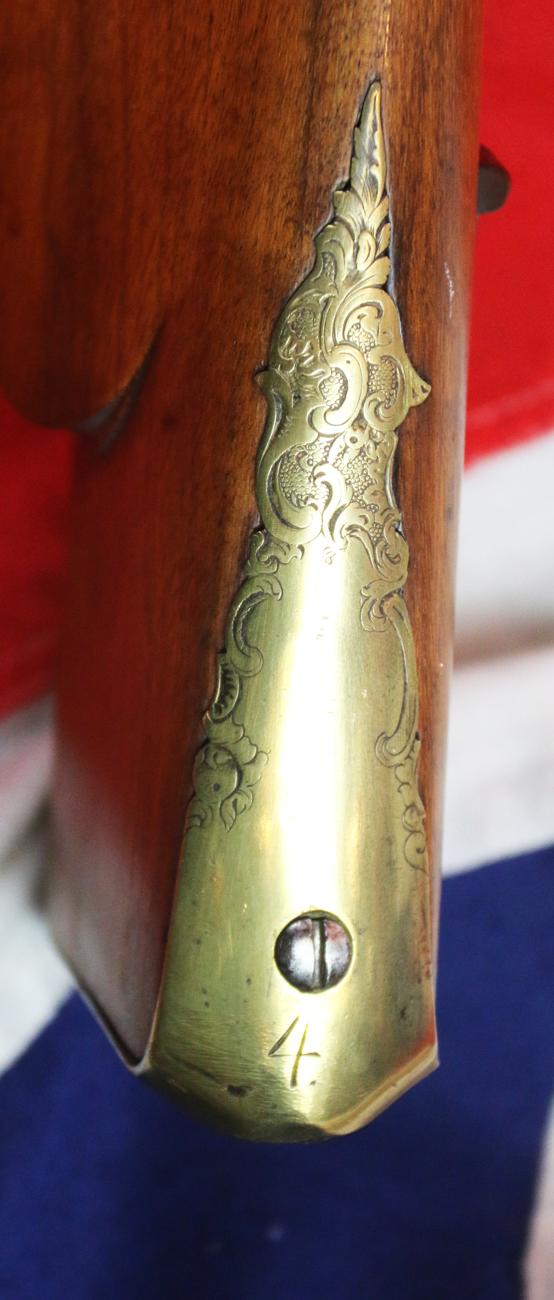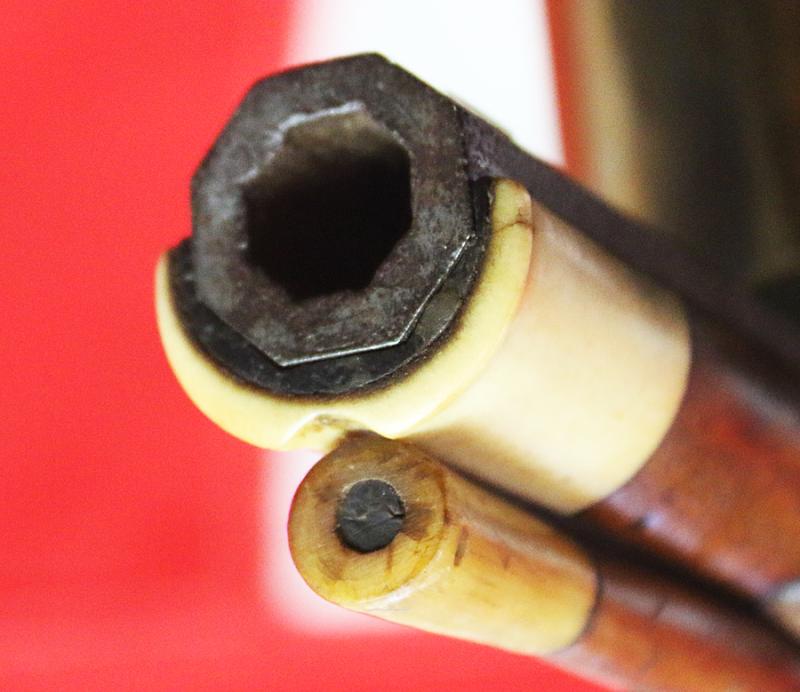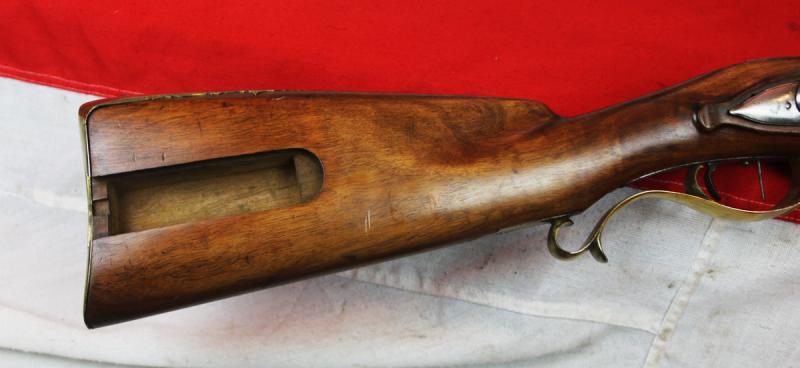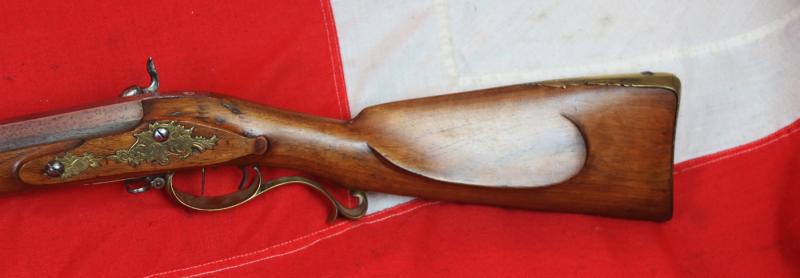A Superb, Late 18th Century Napoleonic Wars Volunteer Jäger Officer’s Rifle. With Finest Walnut Stock And High Quality Mounts, Fine Quality Rifled Barrel of Approx .75 Inch Bore.
Fine walnut full stock, in great polish, with King George IIIrd crown stamp on the inner butt box slide, and carved rifle cheek-piece. Sighted barrel, with the with traditional wooden Jägers patch box, and very finely engraved brass mounts, traditional rifle trigger guard and the butt plate is numbered 4, it has its original rifle ramrod with carved bone end to match the carved bone forend. Superb set trigger action conversion to percussion, in it working life in order to extend its use, and enable its use in foul weather.
An original Napoleonic & Anglo-French wars period issue Officer’s grade rifle, as used by an officer of the 60th Regiment, and the predecessor rifle to the world renown Baker Rifle, that was itself a Jager rifle copy, that was issued to the 95th. Another remarkable thing about this rifle is that is a little more than half the cost today of it's equivalent, yet more well known successor, a regulation issue Baker Rifle. This is due to the fact it does not quite have the fame as associated with the Baker Rifle of the 95th Rifles, much due to the wonderful modern book and film series penned by Bernard Cornwall, ‘Sharp of the 95th’ etc.
These Austro-Prussian made rifles, used by the 60th Rifles Regt. Volunteers, are referred to in British Military Firearms 1650 to 1850 by Howard Blackmore.
The story of the earliest British rifle regiment goes as follows; at the end of 1797 - the year in which the Duke of York became colonel in-chief -of the 60th, it was decided to increase British forces in America, and an Act of Parliament was passed authorizing the Crown "to augment His Majesty's 60th Regiment of Infantry by the addition of a Fifth Battalion," to serve in America only, and to consist of foreigners.
“De Rottenburg organized his new battalion entirely for the special duties of ‘Riflemen.’ They were to be the ‘eyes of the army.’ He instituted a perfect system of drill for riflemen, and out-post duties; this system he printed in a book, which was afterwards embodied in the book of ‘Field Exercise and Evolutions of the Army,’ with a complimentary order by the Duke of York, then Commander-in-Chief.
This battalion, the first green-coated rifle battalion in the Army, was organized under the command of Lieut-Colonel Baron de Rottenburg, of Hompesch's Corps. It was formed of 17 officers and 300 men from Hompesch's Chasseurs, and was dressed in bottle-green cut-away coats with scarlet facings, white waistcoats, blue pantaloons, with black leather helmets and black belts. They were armed, at first, with inferior 'contract' rifles imported from Germany, but after those were rejected this better type was chosen. This fifth or "Jager" battalion served in Ireland in 1798 during the Rebellion, and then proceeded to the West Indies, where, in June, 1799, it received 33 officers and 600 men from Lowenstein's Chasseurs, another regiment of foreigners, at the capture of Surinam in 1791 and afterwards in South and North America.
In 1804 an Act was passed authorizing 10,000 foreign troops to serve in England, and the 5th Battalion was brought home in consequence in 1806. It went to Portugal in June, 1808, and from the opening skirmish at Obidos, on 15th August, two days before the battle of Roleia or Rolica down to the end of the war, took part in Wellington's campaigns in Portugal, Spain and the South of France.
This rifle was used prior to and during the Napoleonic Wars, the Peninsular War, the War of 1812 in America, and in the period of War of the 100 Days at Waterloo. The men in Hompesch’s British rifle corps were of all nations, except English and French and four hundred of the ‘Mounted Riflemen’ formed the nucleus of the new battalion, but they were chiefly Germans, and in Germany Rottenberg placed recruiting officers for the purpose of raising men for Britain's 60th.". "The battalion thus formed was the original of those battalions now so well known, and so distinguished in every sense of the word, as ‘Riflemen.’
The men were dressed and equipped as Jägers. They were armed with rifles, and carried what were called ‘rifle bags’ made of leather, instead of knapsacks; they grew the moustache, and they were dressed in green. In this particular they claim priority, in time, to all other battalions in the British army….” A superbly effective rifle, and a super and fine historical example, with the traditional German style patch box in wood as opposed to the Baker's brass version. A very fine walnut stock, brass furniture, including large ramrod pipes, heavy steel ramrod. Superb tight and crisp action. 30 inch rifled octagonal barrel, 45.5 inches long overall. “The men in Hompesch’s British rifle corps were of all nations, except English and French and four hundred of the ‘Mounted Riflemen’ formed the nucleus of the new battalion, but they were chiefly Germans, and in Germany De Rottenberg placed recruiting officers for the purpose of raising men for Britain's 60th.". "The battalion thus formed was the original of those battalions now so well known, and so distinguished in every sense of the word, as ‘Riflemen.’ The men were dressed and equipped as Jägers. They were armed with rifles, and carried what were called ‘rifle bags’ made of leather, instead of knapsacks; they grew the moustache, and they were dressed in green. In this particular they claim priority, in time, to all other battalions in the British army….” On our previous example, we had a few years ago, it still had inside the patch box, its original hand written label circa 1800, in part English and German, that gave what we believed to be the name of the rifleman 'Kluge' that used it, it's calibre, the gun's number 157, promise right of supply, and notes on it's accuracy at 100 ,150, 200, 250, 300, 400, 500, 600 & 700. We can enclose with our compliments a copy photo of that list, in our previous Jager rifle of the 60th, just to show to the new owner of this rifle, what it once may also have had stuck within the patch box lid. Before the standard Baker rifle, which was a near direct copy of this Jäger rifle, replaced the Jäger rifles, this was the rifle acquired by England from Prussia, by the British ordnance, and was issued to the earliest British rifle regiment the 60th, formed in the late 18th century. They were then used in America and Ireland, and then in Spain, Portugal & France
The riflemen were the first to fight the French at Obidos on Aug. 15, and then again played a leading role in the Battle of Roliça two days later.
Following Roliça, Wellesley decided to take five companies of the 5/60th and place them in each of the other brigades. This would strengthen the light companies of the battalions in those brigades and give them some rifle-armed troops. The decision was quickly vindicated by the 5/60th’s performance at the Battle of Vimeiro on Aug. 21. Not only did the five companies that were still brigaded with the 95th help defeat an attack on Wellesley’s centre, but the detached companies were present wherever the French attacked.
They also quickly gained a reputation for targeting French officers. Charles Leslie of the 29th Foot wrote:
“In this battle the 60th Riflemen, who were all Germans, showed great tact in taking advantage of the ground and dexterity in the use of their arms. General Fane, who commanded the light troops, observing one of these men successfully hit one or two French officers who were gallantly exposing themselves in front leading on their men, exclaimed in the excitement of the moment, ‘Well done, my fine fellow! I will give you half a doubloon for every other one you bring down.’ The man coolly loaded again, fired, and hit another, then looking at the General, he said gravely, ‘By Got, I vill make my vortune’.”
This rifle is a superb piece, in fabulous condition in all parts, walnut brass and steel. The action is as tight as a drum. And the walnut patina is a beautiful golden brown.
In the picture in the gallery there is a photograph of a 60th Rifleman next to a 95th in the Peninsular War. And another photograph we show is of another 60th rifles rifle patch box lid that we had on another Jager rifle of the 60th, some years ago, and on that rifle, affixed on that patch box lid, were written his site windage adjustments. Note the photo in the gallery of the 60th Rifleman's patch box lid inner side on our past 60th Jäger Rifle, {not of this rifle}.
We noticed inside this rifles patchbox lid, a feint, GR crown military inspection stamp.
As with all our antique guns no license is required as they are all unrestricted antique collectables
Every item is accompanied with our unique, Certificate of Authenticity. Of course any certificate of authenticity, given by even the best specialist dealers, in any field, all around the world, is simply a piece of paper,…however, ours is backed up with the fact we are the largest dealers of our kind in the world, with over 100 years and four generation’s of professional trading experience behind us
Code: 24769
5750.00 GBP

